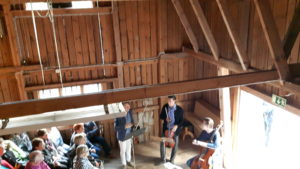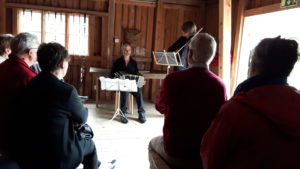Chamber Music Festival Kuhmo 2017 and follow-up – Part Three: My follow-up of videos with Sergey Malov
In my two previous posts I have reported on my/our cultural highlight of this year – the Kuhmo Chamber Music Festival, July 2017. This was a shared experience between my partner Johanna (who has been a regular visitor since the early days of the festival) and myself (a latterly joined ‘avec’ who has learned to appreciate the festival). In my first post I told of the background of the festival and provided insights into the highlights of the Kuhmo 2017 program. In my second post I told of the meeting point ‘Salakamari’ (Secret chamber) and of the early morning lectures by artists in this pop-up restaurant and conference room. Indeed, my Kuhmo experience this year changed me from a passive sympathiser to an enthusiastic follower. I needed to learn more of this great music played by this great artists – who pointed out to be very nice fellows in the Kuhmo neighbourhood. For various reasons my follow-up ‘project’ has mainly focused on the music and video performances of Sergey Malov – Meister Sergey, as I prefer to call him. Below I will present some main points what I have found of him in the internet and what I have learned of him.
Playing violin, viola and violoncello da spalla at the same time
As has been indicated in the previous posts, Meister Sergey plays three instruments – violin, viola and the baroc instrument violoncello da spalla at the same time. For many traditional representatives of classical music this is unusual, if not suspect. For Meister Sergey this is a challenge and enrichment, something similar to learning several languages. And thanks to modern film techniques, he has been able to make his point. Together with the film crew of the Louisiana Modern Art Museum in Humlebaek, Denmark, he has produced films in which he appears to be playing the three instruments parallel to two or more Sergeys – and the music is fully synchronised. Here we have a sample of such multiple presence while playing:
Crossing the boundaries between different cultures and genres – making the performance transparent
Another film production with the same Danish film crew from the Louisiana Modern Art Museum gave Meister Sergey and his French counterparts, the composer Guillaume Connesson and the pianist Jerome Ducrot, a chance to demonstrate, how cultural boundaries can be crossed. In the video interview Meister Sergey gives insights into the development of Connesson, his capability to combine French traditions and American influences. Sergey analyses the exemplary piece of music – The Songs of Atlantis by Connesson – to be played by him and Ducrot together. At the same time the film crew equips the musicians and their instruments with numerous cameras to detect their movements – their Handwerk – while playing. In this way, the theory of music, the aesthetic performance and the technical mastery have all been made transparent.
Playing Bach with violoncello da spalla in a very special ‘concert hall’ – Gashouder Amsterdam
One of the most fascinating video recordings with Meister Sergey was made by the project “All of Bach” of the Netherlands Bach Society. In this production Sergey has been invited to play the Cello Suite no. 6 in D major of Johann Sebastian Bach – but with violoncello da spalla. And the venue is quite special – an old gas depot that had been preserved and could be reused for a concert without audience. The production resulted in three videos. The first one is the complete performance of the Suite no. 6. In the second video Sergey analyses the piece of music and puts into discussion the hypothesis that it was in fact written for an instrument with five strings. He demonstrates in a lively way, how this makes more sense regarding the technique of playing it. Finally, in the third video he discusses his instrument, violoncello da spalla and its potentials. In these videos Sergey speaks his native Russian but the videos have either English or Dutch subtitles. Please follow the link to access this treasury: http://allofbach.com/en/bwv/bwv-1012/
The rediscovery of violoncello da spalla – and what you can do with it
The final video in this sample is the recording of an informal conversation between Meister Sergey and Dmitry Badiarov, the violin constructor who had built the violoncello da spalla for Sergey. At first they start jokingly discussing, what it means for a musician to be ‘tagged’ as a specialist of a rare instrument. But then, when getting to the subject matter, they bring into picture evidence that some baroc compositions were explicitly written either for ‘viola da gamba’ or ‘da spalla’. If these two instruments were considered as equal options at that time, the present date musicians should explore the treasury written for viola da gamba also with violoncello da spalla. And having agreed on this, the friends of old then give a demonstration by playing together. And clearly the motto was ‘happy together’. Follow the link below and enjoy it as well:
https://www.facebook.com/violoncellodaspalla/videos/1360640140711419/
– – –
I think this is enough of the learning journey that I have had after the Kuhmo event. I notice that I have not mentioned the records of Meister Sergey or the video recordings of his concerts. More information is available on his website http://sergeymalov.com/ or on his professional facebook page. As far as I am concerned, I have learned a lot with this follow-up of the magnificent Kuhmo experience.
And with this blog post I wish you all a happy Christmas time and a good slide to the new year 2018!
More blogs to come (next year) …


